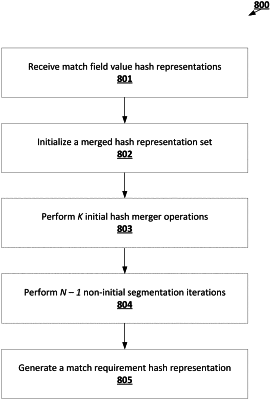| CPC G06F 16/2456 (2019.01) [G06F 16/21 (2019.01); G06F 16/2423 (2019.01); G06F 16/2425 (2019.01)] | 20 Claims |

|
1. A computer-implemented method for performing one or more database management operations in relation to a query-compliant hash database, the computer-implemented method comprising:
identifying, using one or more processors, a segmentation-based hashing model, wherein the segmentation-based hashing model is configured to:
for each match field value of match field values of a hashing input data object that are subject to a match requirement, generate each match field value hash representation,
perform, via segmentation iterations, a sequence of hash merger operations on said each match field value hash representation for the hashing input data object to generate a match requirement hash representation for the hashing input data object,
wherein: (i) during an initial segmentation iteration of the segmentation iterations, the segmentation-based hashing model performs initial hash merger operations to generate a merged hash representation set comprising initial merged hash representations, each initial merged hash representation of the initial merged hash representations being generated by combining the match field value hash representations for a corresponding subset of data field values associated with the match field values,
(ii) during each non-initial segmentation iteration, the segmentation-based hashing model performs a corresponding non-initial hash merger operation to update the merged hash representation set by replacing a defined subset of the merged hash representation set with a resulting merged hash representation, and
(iii) during a final segmentation iteration of the segmentation iterations, the segmentation-based hashing model performs a corresponding hash merger operation to update the merged hash representation set by replacing all of the merged hash representation set with the match requirement hash representation, and generate an output hash representation combination for the hashing input data object based at least in part on the match requirement hash representation;
generating, using the one or more processors and the segmentation-based hashing model and based at least in part on a plurality of query field values of a database query received from a computing device, a query hash representation combination for the segmentation-based hashing model, wherein the query hash representation combination is the output hash representation combination generated by the segmentation-based hashing model via processing the database query as the hashing input data object;
generating, using the one or more processors and based at least in part on the query hash representation combination, a refined database query corresponding for the database query;
performing, using the one or more processors, one or more query retrieval operations corresponding to the refined database query and in relation to the query-compliant hash database in order to generate one or more refined query results; and
performing, using the one or more processors, the one or more database management operations based at least in part on the one or more refined query results.
|